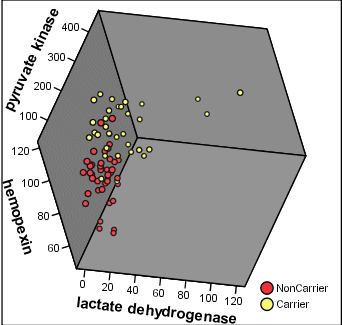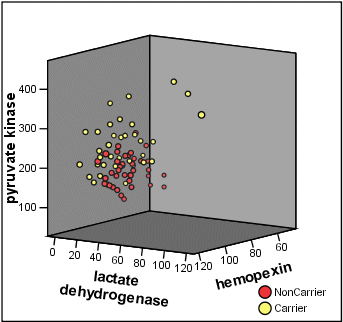Outline
There are two example analyses.
The data can be downloaded in two formats from the links below
| DA | Text | Excel |
|---|---|---|
| Muscular Dystrophy |  |
|
| Multigroup Discriminantion |  |
Duchenne Muscular Dystrophy
We can envisage two questions.
- What differences, if any, are there in the potential predictors between carriers and non-carriers of Duchenne Muscular Dystrophy?
- Given a set of measurements isit possible to predict if someone is a carrier of Duchenne Muscular Dystrophy?
There are four potential predictors (original source of data and the units are unknown).
1. creatine kinase
2. hemopexin
3. lactate dehydrogenase
4. pyruvate kinase
3-D scatter plots, viewed in different projections, suggest that some projections look promising for separating the two groups.


The example analyses were undertaken using SPSS. The output includes most of the optional analysis extras. The default output is much more abbreviated.
Two analyses are shown. The first uses all four variables and the second uses a stepwise procedure.
Multigroup discrimination of eagle habitat
The question addressed by this analysis is 'Is it possible to discriminate between the core areas of golden eagle home ranges from three regions of Scotland?' The data consist of eight habitat variables. The values are the amounts of each habitat variables, measured as the number of 4 ha blocks within a region defined as a 'core area'.
| Name | Description | |
|---|---|---|
| POST | Post canopy forest : mature planted conifer forest | |
| PRE | Pre-canopy closure conifer forest (young trees) | |
| BOG | Bog (flat water logged) | |
| CALL | Calluna (Heather) heathland | |
| WET | Wet heath, mainly purple moor grass | |
| STEEP | Steeply sloping land | |
| LT200 | Land below 200m | |
| L4_600 | Land between 200 & 400m | |
Three analyses are available.

